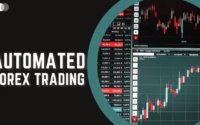How to Build a Successful Forex Trading Plan
Introduction:
Forex trading offers immense opportunities for individuals to participate in the global financial markets and generate substantial profits. However, trading in the forex market requires a well-thought-out plan to navigate the complexities and increase the chances of success. This guide will discuss the key steps to build a successful forex trading plan.
1. Define Your Goals and Risk Tolerance:
The first step in building a trading plan is clearly defining your goals. Ask yourself: What are you looking to achieve through forex trading? Are you aiming for consistent profits, long-term wealth accumulation, or diversifying your investment portfolio? Setting clear goals will help you align your trading strategies accordingly.
Additionally, assess your risk tolerance. Forex trading involves substantial risk, and it is crucial to determine the amount of capital you are willing to risk per trade and overall. Understanding your risk tolerance will guide your position sizing and risk management strategies.
2. Conduct Thorough Market Analysis:
Successful forex trading requires a deep understanding of the market. Begin by studying the fundamental factors that impact currency movements, such as economic indicators, monetary policy decisions, geopolitical events, and news releases. Additionally, analyze technical indicators, charts, and patterns to identify potential entry and exit points.
3. Choose a Trading Methodology:
Various trading methodologies exist in the forex market, including day trading, swing trading, and long-term trend following. Each approach has its advantages and requires specific skills. Determine which methodology aligns with your trading goals, time availability, and risk tolerance.
4. Develop a Trading Strategy:
Once you have chosen a trading methodology, develop a strategy that complements it. Define your entry and exit criteria, risk-reward ratio, and stop-loss and take-profit levels. A well-defined system provides a structured approach to trading and helps eliminate impulsive decisions driven by emotions.
5. Implement Risk Management Techniques:
Effective risk management is paramount in forex trading. Determine the maximum percentage of your trading capital you are willing to risk per trade. Many traders follow the “1% rule,” which suggests betting no more than 1% of your trading capital on a single transaction. Additionally, set stop-loss orders to limit potential losses and employ trailing stops to protect profits as the trade moves in your favour.
6. Maintain a Trading Journal:
Keeping a trading journal is an essential habit for every forex trader. Record your trades, including entry and exit points, reasons for entering the business, and your emotional state during the work. Regularly reviewing your journal will help you identify strengths, weaknesses, and areas for improvement, leading to more informed decision-making.
7. Monitor and Adjust:
The forex market is dynamic, and conditions can change rapidly. Regularly monitor your trades, market developments, and economic news. Be prepared to adjust your trading plan as necessary. Avoid overtrading and be patient for high-probability setups that align with your trading strategy.
8. Practice Proper Money Management:
Money management is an integral part of successful forex trading. Avoid risking too much capital on a single trade, leading to significant losses. Instead, diversify your businesses and allocate money based on the risk-reward ratio and your confidence in each work. Additionally, avoid the temptation of chasing losses or doubling down on losing positions.
9. Continuously Educate Yourself:
The forex market constantly evolves, and staying informed and continuously educating yourself is crucial. Read books, attend webinars, participate in trading communities, and follow reputable financial news sources to enhance your knowledge and skills. Continuous learning will improve your decision-making abilities and update you with the latest market trends.
10. Embrace Discipline and Emotional Control:
Lastly, building a successful trading plan requires discipline and emotional control. Stick to your trading strategy and avoid letting emotions dictate your decisions. Fear, greed, and impatience can lead to impulsive and irrational trading, resulting in losses. Follow your plan diligently, even during drawdown periods or when faced with tempting opportunities that do not align with your strategy.
Maintaining discipline also includes sticking to your risk management principles. Do not deviate from your predetermined risk tolerance and position sizing. Consistency is critical to long-term success in forex trading.
Remember, building a successful trading plan is an ongoing process. Regularly assess your progress, review your trading journal, and make adjustments as needed. Forex trading requires dedication, patience, and continuous learning. With a well-structured plan and disciplined execution, you can embark on a successful forex trading journey and achieve your financial goals.
11. Backtest and Demo Trade:
Before risking natural capital, backtest your trading strategy using historical data to assess its performance. This process allows you to evaluate and refine the strategy’s profitability. Additionally, practice trading in a demo account to gain hands-on experience without risking real money. Demo trading helps you familiarize yourself with the platform and test your strategy in real-time market conditions.
12. Set Realistic Expectations:
While forex trading can be highly profitable, it is crucial to set realistic expectations. Understand that consistent profits take time, and losses are a part of the trading process. Avoid getting swayed by exaggerated claims or promises of overnight success. Instead, focus on long-term profitability and aim for steady, sustainable growth.
13. Diversify Your Portfolio:
Diversification is critical to managing risk in forex trading. Avoid overconcentration in a single currency pair or market. Spread your trades across different currency pairs and consider including other asset classes in your portfolio, such as stocks or commodities. Diversification helps mitigate the impact of adverse market movements on your overall portfolio.
14. Be Mindful of News Events:
News events can have a significant impact on the forex market. Stay informed about economic releases, central bank announcements, and geopolitical developments that can influence currency prices. Consider creating a calendar of important events and adjust your trading plan accordingly. Avoid initiating new trades or tightening your stop-loss levels during high-impact news releases to protect against sudden market volatility.
15. Seek Mentorship or Join a Trading Community:
Trading can be a solitary endeavour, but seeking mentorship or joining a trading community can provide valuable insights and support. Engage with experienced traders who can share their knowledge, strategies, and trading tips. Participating in discussions, forums, or social media groups can also offer an opportunity to learn from others, gain new perspectives, and stay motivated.
16. Regularly Review and Evaluate:
Consistently review and evaluate your trading plan and performance. Assess the effectiveness of your strategies, identify areas for improvement, and make necessary adjustments. This ongoing evaluation will help you adapt to changing market conditions and refine your trading plan.
17. Manage Your Emotions:
Emotions play a significant role in trading decisions. Fear and greed can cloud judgment and lead to impulsive actions. Develop strategies to manage your feelings, such as taking breaks during high stress, practising mindfulness techniques, or having a support system to discuss and process your trading experiences. Emotional control is crucial to maintaining discipline and making rational decisions.
18. Consider Professional Guidance:
If you are new to forex trading or need help to achieve consistent profitability, consider seeking professional guidance. A reputable forex trading coach or mentor can provide personalized advice, help you identify weaknesses in your trading plan, and offer guidance on improving your skills. Professional guidance can accelerate your learning curve and increase your chances of success.
19. Define Your Trading Schedule:
Establish a trading schedule that aligns with your lifestyle and availability. Forex markets are open 24 hours a day, but you can still trade around the clock. Determine the most suitable trading sessions based on your time zone and when the currency pairs you trade are most active. A consistent routine will help you stay focused and avoid impulsive trading decisions.
20. Monitor Market Correlations:
Be mindful of the correlations between currency pairs and other markets. Specific currency pairs strongly relate to commodities, stock markets, or interest rates. Understanding these correlations can provide insights into potential market movements and help you make more informed trading decisions. Consider incorporating market correlation analysis into your trading plan.
21. Practice Patience:
Patience is a virtue in forex trading. Avoid the temptation to chase after every trade or enter positions impulsively. Wait for high-probability setups that align with your trading strategy. Remember, not every price movement presents a profitable opportunity. Being patient and selective with your trades can significantly improve your overall success rate.
22. Maintain Realistic Risk-to-Reward Ratios:
When setting up your trades, ensure that your potential reward justifies your risk. A favourable risk-to-reward ratio means the potential profit is significantly higher than the possible loss. Aim for businesses with a risk-to-reward ratio of at least 1:2 or higher. This way, even if you have a few losing trades, your winning trades can still bring you profits.
23. Regularly Update Your Trading Plan:
The forex market is dynamic, and your trading plan should reflect that. Regularly review and update your program based on your trading experiences and market observations. You may identify or refine new strategies as you gain more knowledge and experience. Adapting your plan to changing market conditions is crucial to staying relevant and maximizing your trading performance.
24. Utilize Stop-Loss Orders:
Always use stop-loss orders to manage risk effectively. A stop-loss order is an automatic instruction to close a trade if it reaches a predetermined price level. It helps limit potential losses and protects your trading capital. Place your stop-loss orders at a logical level based on technical analysis or your risk tolerance. Avoid moving or removing stop-loss charges during trades, as it exposes you to unnecessary risk.
25. Be Prepared for Drawdowns:
Drawdowns, or temporary losses, are an inevitable part of trading. Prepare yourself mentally and financially for drawdown periods. Set aside sufficient trading capital to withstand potential losses without jeopardizing your financial stability. Remember that drawdowns are average and can be overcome with disciplined trading and adherence to your plan.
26. Continuously Monitor and Improve:
Successful forex trading requires continuous learning and improvement. Stay updated with market trends, economic news, and evolving trading strategies. Attend seminars, webinars, and workshops to expand your knowledge base. Actively seek feedback from experienced traders and use it to refine your skills. Adopting a growth mindset and a commitment to self-improvement can significantly enhance your trading performance.
27. Stay Disciplined During Winning Streaks:
Winning streaks can be as challenging to manage as losing streaks. When experiencing a series of profitable trades, maintain discipline and stick to your trading plan. Stay confident and take appropriate risks. Stick to your risk management principles and avoid deviating from your established strategies. Disciplined trading during winning streaks helps protect your profits and prevents complacency.
Conclusion:
A successful forex trading plan is essential for navigating the complex and dynamic market. You can increase your chances of success by defining your goals, conducting a thorough market analysis, choosing a suitable methodology, and developing a trading strategy. Implementing effective risk management techniques, maintaining a trading journal, continuously educating yourself, and embracing discipline will enhance your trading performance.


